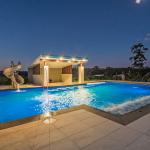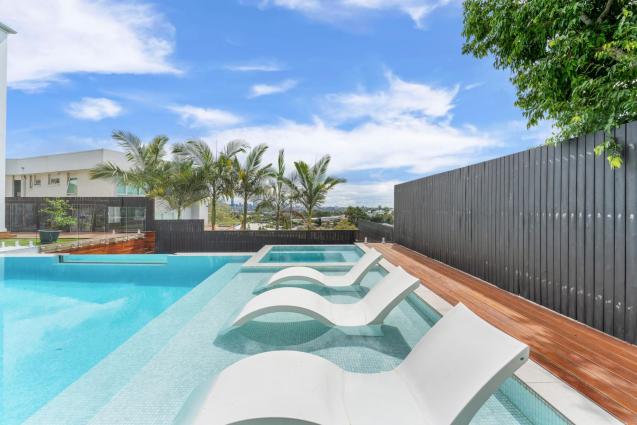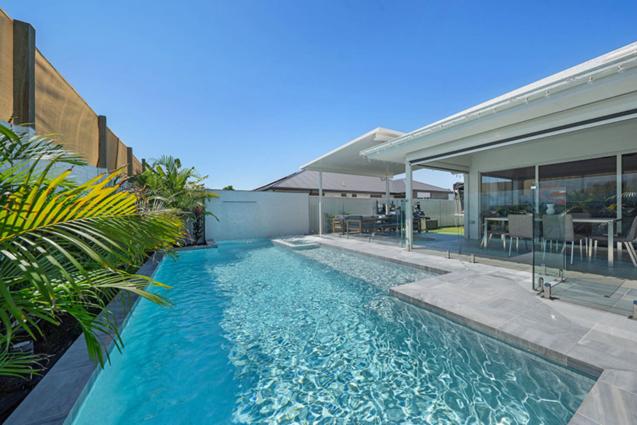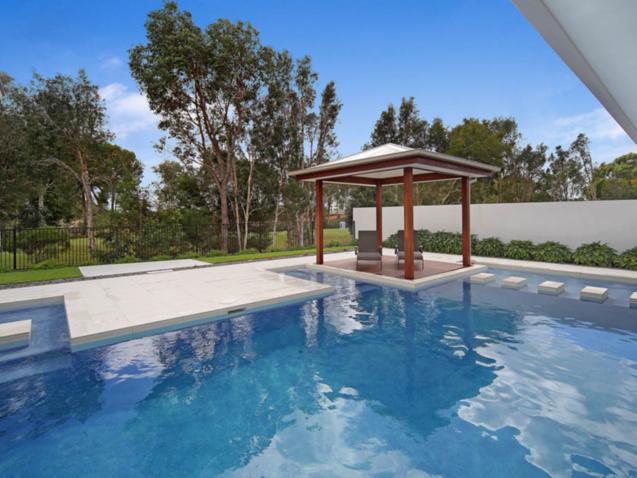
Concrete vs Fibreglass Pools: Things You Need to Consider
By Ecozen Pools + Landscapes|July 14, 2023
Pools are a great way to add value to your home while also creating a fun and relaxing environment for your family and friends to enjoy. Whether you're building a new pool or considering a renovation, choosing the right type can be a difficult decision. Two of the most popular pool types are concrete and fibreglass.
In this article, we'll cover everything you need to know about these two materials to help you make an informed decision.
Lifespan
Concrete pools have stood the test of time when it comes to durability and longevity. These pools are renowned for their ability to withstand even the harshest weather conditions, making them a popular choice in regions prone to extreme temperatures or frequent natural disasters. Whether you're dealing with scorching summers or freezing winters, a well-constructed concrete swimming pool can handle it all.
However, it's important to note that concrete pools are not impervious to wear and tear. Over time, they may develop cracks due to ground movement or shifting. While these cracks can be repaired, they do require attention and maintenance to prevent water leakage and further damage.
Additionally, concrete pools typically require periodic resurfacing to maintain their aesthetic appeal and structural integrity. This process involves applying a new layer of plaster or a more durable finish to keep the pool surface smooth and attractive.
Fibreglass Pools
Fibreglass pools offer a considerable lifespan that can rival that of concrete pools. These pools are constructed using a single-piece fibreglass shell that is incredibly resilient and resistant to cracks. Unlike concrete, fibreglass does not have the same propensity to develop cracks due to ground movement or shifting. This characteristic gives fibreglass pools a significant advantage in terms of long-term durability.
Moreover, fibreglass pools are designed to resist fading caused by prolonged exposure to the sun's harmful UV rays. Manufacturers employ various techniques, such as incorporating UV inhibitors and gel coatings, to ensure that the pool's surface maintains its vibrant colour and doesn't succumb to sun-induced wear and discoloration.
Maintenance Requirements
Concrete Pools
Concrete pools require regular maintenance to keep them clean, safe, and in optimal condition. As a pool owner, you'll need to dedicate time to several maintenance tasks to ensure the longevity of your concrete pool.
Regular cleaning is essential. Over time, debris, leaves, and dirt can accumulate on the pool's surface and settle on the bottom. This debris must be removed to maintain the pool's cleanliness and prevent any potential clogging of the filtration system. Skimming the water's surface with a net and vacuuming the pool floor will help keep it pristine.
Maintaining proper chemical balance is another crucial aspect of concrete pool maintenance. Regular testing of the pool water's pH levels and chlorine levels is necessary to ensure optimal water quality and safety for swimmers. Adjustments may need to be made by adding chemicals to maintain the appropriate balance.
One of the challenges with concrete pools is the potential for algae growth. The porous nature of concrete can provide a breeding ground for algae if not properly managed. Regular brushing of the pool's walls and floor can help prevent algae buildup and keep the surface smooth. Algaecides and other chemical treatments may also be required periodically to control and prevent algae growth.
Fibreglass Pools
One of the standout advantages of fibreglass pools is their low-maintenance nature. The smooth, non-porous surface of fibreglass resists the growth of algae, making it easier to maintain a clean and clear pool.
Unlike concrete pools, fibreglass pools require less frequent cleaning. The non-porous surface makes it difficult for debris and algae to adhere to the pool's walls and floor. This means less time spent on manual cleaning tasks such as scrubbing and brushing.
While Fibreglass pools require less cleaning, occasional maintenance is still necessary. Regularly skimming the water's surface and vacuuming the pool floor will help remove any floating debris or settled particles.
Just like with any pool, maintaining the proper chemical balance is crucial for a fibreglass pool as well. Regular testing of pH and chlorine levels should be conducted to ensure the water remains safe and inviting for swimmers. Adjustments may need to be made by adding chemicals to maintain the desired balance.
Installation Procedures
Concrete Pools
Constructing a concrete pool requires careful planning, excavation, and precise execution. The construction timeline for concrete pools is typically longer compared to fibreglass pools, but the end result can be truly remarkable.
The first step in installing a concrete pool involves excavation. A hole is carefully dug in your backyard, following the pool's desired shape and size. This excavation process requires skilled professionals who will ensure that the hole is properly levelled and prepared for the pool's construction.
Once the excavation is complete, the construction of a concrete pool involves several essential components. Steel reinforcement is crucial to provide structural support and prevent the pool from cracking or shifting over time. Reinforcing steel bars, also known as rebar, are strategically placed throughout the pool's foundation, walls, and floor.
Another significant aspect of the installation process is plumbing. Plumbing lines need to be carefully integrated into the pool's structure to ensure proper water circulation and filtration. This step requires expertise in plumbing to ensure that all connections are secure and efficient.
One of the advantages of concrete pools is the level of customisation they offer during construction. Since concrete is a highly versatile material, you can shape your pool to fit your desired design, incorporating unique features such as waterfalls, integrated spas, or custom steps. The possibilities for customisation are extensive, allowing you to create a truly personalised swimming experience.
Fibreglass Pools
If you're seeking a faster installation process, fibreglass pools might be the right choice for you. Installing a fibreglass pool typically takes less time compared to a concrete pool, thanks to the premanufactured nature of fibreglass pool shells.
The installation process of a fibreglass pool begins with excavation, similar to that of a concrete pool. The hole is carefully dug according to the pool's specifications, ensuring a level and properly sized space. Once the excavation is complete, the fibreglass pool shell is delivered to your location.
To install the fibreglass pool, a crane is used to carefully lower the pool shell into the excavated hole. This step requires the expertise of professionals to ensure a safe and precise installation. Once the pool shell is in place, the necessary plumbing connections are made, and the area around the pool is backfilled and properly compacted.
One aspect to consider when opting for a fibreglass pool is the limited customisation options available during the installation process. Unlike concrete pools, which can be shaped and customised extensively, fibreglass pools come in preformed shapes and sizes. While you can choose from a range of designs, colours, and finishes offered by manufacturers, the flexibility for customisation is more restricted compared to concrete pools.
Overall Cost
Concrete Pools
When considering the overall cost of a concrete pool, it's essential to account for both the initial construction expenses and the long-term maintenance and repair costs. The initial cost of constructing a concrete pool can be higher compared to other options due to the labour-intensive nature of the process and the need for excavation and steel reinforcement. Additionally, the excavation itself can add to the upfront expenses.
However, it's important to note that concrete pools offer longevity and durability, potentially outweighing the initial investment. Over time, though, concrete pools may require resurfacing, especially if cracks or deterioration occur. Resurfacing can add to the long-term expenses of maintaining a concrete pool. Repairs, such as fixing leaks or addressing structural issues, can also contribute to ongoing costs.
Another factor to consider is the potential for higher utility bills with concrete pools. Concrete pools generally have larger water volumes compared to fibreglass pools, which means more water to heat and treat. This increased water volume can result in higher energy consumption and, consequently, higher utility bills. It's crucial to factor in these potential long-term costs when considering a concrete pool.
Fibreglass Pools
When it comes to the upfront cost, fibreglass pools generally have a lower price tag compared to concrete pools. The manufacturing process allows for prefabricated pool shells that are ready to be installed. This streamlined production process helps reduce labour and construction time, contributing to the lower upfront cost.
One significant advantage of fibreglass pools lies in their long-term maintenance and repair savings. The non-porous surface of fibreglass resists algae growth, reducing the need for frequent cleaning and chemical treatments. This low-maintenance characteristic can translate into cost savings over time, as less time and money will be spent on pool maintenance.
Additionally, fibreglass pools are known for their structural integrity and resistance to cracks and leaks. The durable nature of fibreglass helps minimise the need for repairs and ensures a longer lifespan for the pool. With fewer repair expenses, fibreglass pool owners can enjoy potential long-term savings.
Moreover, fibreglass pools have a smaller water volume compared to concrete pools. This lower water volume results in reduced energy consumption for heating and treating the pool water, leading to lower utility bills. The energy efficiency of fibreglass pools can contribute to long-term cost savings.
Conclusion
Both concrete and fibreglass pools offer unique advantages and considerations. Concrete pools provide durability and customisation options but require more maintenance and have higher upfront and long-term costs. fibreglass pools, on the other hand, offer low-maintenance, faster installation, and potential cost savings. Consider your climate, pool size, design preferences, and maintenance preferences when making your decision.
For those seeking a customised and long-lasting pool, concrete may be the best choice. However, if convenience, lower maintenance, and cost-effectiveness are your priorities, fibreglass pools are a fantastic option. Take the time to weigh the pros and cons and consult with a pool professional to ensure your choice aligns with your needs and desires for your dream pool.
If you’re looking to have a concrete pool built for your residential or commercial property, get in touch with Ecozen. Specialists in pool and landscape packages.
In this article, we'll cover everything you need to know about these two materials to help you make an informed decision.
Lifespan
Concrete pools have stood the test of time when it comes to durability and longevity. These pools are renowned for their ability to withstand even the harshest weather conditions, making them a popular choice in regions prone to extreme temperatures or frequent natural disasters. Whether you're dealing with scorching summers or freezing winters, a well-constructed concrete swimming pool can handle it all.
However, it's important to note that concrete pools are not impervious to wear and tear. Over time, they may develop cracks due to ground movement or shifting. While these cracks can be repaired, they do require attention and maintenance to prevent water leakage and further damage.
Additionally, concrete pools typically require periodic resurfacing to maintain their aesthetic appeal and structural integrity. This process involves applying a new layer of plaster or a more durable finish to keep the pool surface smooth and attractive.
Fibreglass Pools
Fibreglass pools offer a considerable lifespan that can rival that of concrete pools. These pools are constructed using a single-piece fibreglass shell that is incredibly resilient and resistant to cracks. Unlike concrete, fibreglass does not have the same propensity to develop cracks due to ground movement or shifting. This characteristic gives fibreglass pools a significant advantage in terms of long-term durability.
Moreover, fibreglass pools are designed to resist fading caused by prolonged exposure to the sun's harmful UV rays. Manufacturers employ various techniques, such as incorporating UV inhibitors and gel coatings, to ensure that the pool's surface maintains its vibrant colour and doesn't succumb to sun-induced wear and discoloration.
Maintenance Requirements
Concrete Pools
Concrete pools require regular maintenance to keep them clean, safe, and in optimal condition. As a pool owner, you'll need to dedicate time to several maintenance tasks to ensure the longevity of your concrete pool.
Regular cleaning is essential. Over time, debris, leaves, and dirt can accumulate on the pool's surface and settle on the bottom. This debris must be removed to maintain the pool's cleanliness and prevent any potential clogging of the filtration system. Skimming the water's surface with a net and vacuuming the pool floor will help keep it pristine.
Maintaining proper chemical balance is another crucial aspect of concrete pool maintenance. Regular testing of the pool water's pH levels and chlorine levels is necessary to ensure optimal water quality and safety for swimmers. Adjustments may need to be made by adding chemicals to maintain the appropriate balance.
One of the challenges with concrete pools is the potential for algae growth. The porous nature of concrete can provide a breeding ground for algae if not properly managed. Regular brushing of the pool's walls and floor can help prevent algae buildup and keep the surface smooth. Algaecides and other chemical treatments may also be required periodically to control and prevent algae growth.
Fibreglass Pools
One of the standout advantages of fibreglass pools is their low-maintenance nature. The smooth, non-porous surface of fibreglass resists the growth of algae, making it easier to maintain a clean and clear pool.
Unlike concrete pools, fibreglass pools require less frequent cleaning. The non-porous surface makes it difficult for debris and algae to adhere to the pool's walls and floor. This means less time spent on manual cleaning tasks such as scrubbing and brushing.
While Fibreglass pools require less cleaning, occasional maintenance is still necessary. Regularly skimming the water's surface and vacuuming the pool floor will help remove any floating debris or settled particles.
Just like with any pool, maintaining the proper chemical balance is crucial for a fibreglass pool as well. Regular testing of pH and chlorine levels should be conducted to ensure the water remains safe and inviting for swimmers. Adjustments may need to be made by adding chemicals to maintain the desired balance.
Installation Procedures
Concrete Pools
Constructing a concrete pool requires careful planning, excavation, and precise execution. The construction timeline for concrete pools is typically longer compared to fibreglass pools, but the end result can be truly remarkable.
The first step in installing a concrete pool involves excavation. A hole is carefully dug in your backyard, following the pool's desired shape and size. This excavation process requires skilled professionals who will ensure that the hole is properly levelled and prepared for the pool's construction.
Once the excavation is complete, the construction of a concrete pool involves several essential components. Steel reinforcement is crucial to provide structural support and prevent the pool from cracking or shifting over time. Reinforcing steel bars, also known as rebar, are strategically placed throughout the pool's foundation, walls, and floor.
Another significant aspect of the installation process is plumbing. Plumbing lines need to be carefully integrated into the pool's structure to ensure proper water circulation and filtration. This step requires expertise in plumbing to ensure that all connections are secure and efficient.
One of the advantages of concrete pools is the level of customisation they offer during construction. Since concrete is a highly versatile material, you can shape your pool to fit your desired design, incorporating unique features such as waterfalls, integrated spas, or custom steps. The possibilities for customisation are extensive, allowing you to create a truly personalised swimming experience.
Fibreglass Pools
If you're seeking a faster installation process, fibreglass pools might be the right choice for you. Installing a fibreglass pool typically takes less time compared to a concrete pool, thanks to the premanufactured nature of fibreglass pool shells.
The installation process of a fibreglass pool begins with excavation, similar to that of a concrete pool. The hole is carefully dug according to the pool's specifications, ensuring a level and properly sized space. Once the excavation is complete, the fibreglass pool shell is delivered to your location.
To install the fibreglass pool, a crane is used to carefully lower the pool shell into the excavated hole. This step requires the expertise of professionals to ensure a safe and precise installation. Once the pool shell is in place, the necessary plumbing connections are made, and the area around the pool is backfilled and properly compacted.
One aspect to consider when opting for a fibreglass pool is the limited customisation options available during the installation process. Unlike concrete pools, which can be shaped and customised extensively, fibreglass pools come in preformed shapes and sizes. While you can choose from a range of designs, colours, and finishes offered by manufacturers, the flexibility for customisation is more restricted compared to concrete pools.
Overall Cost
Concrete Pools
When considering the overall cost of a concrete pool, it's essential to account for both the initial construction expenses and the long-term maintenance and repair costs. The initial cost of constructing a concrete pool can be higher compared to other options due to the labour-intensive nature of the process and the need for excavation and steel reinforcement. Additionally, the excavation itself can add to the upfront expenses.
However, it's important to note that concrete pools offer longevity and durability, potentially outweighing the initial investment. Over time, though, concrete pools may require resurfacing, especially if cracks or deterioration occur. Resurfacing can add to the long-term expenses of maintaining a concrete pool. Repairs, such as fixing leaks or addressing structural issues, can also contribute to ongoing costs.
Another factor to consider is the potential for higher utility bills with concrete pools. Concrete pools generally have larger water volumes compared to fibreglass pools, which means more water to heat and treat. This increased water volume can result in higher energy consumption and, consequently, higher utility bills. It's crucial to factor in these potential long-term costs when considering a concrete pool.
Fibreglass Pools
When it comes to the upfront cost, fibreglass pools generally have a lower price tag compared to concrete pools. The manufacturing process allows for prefabricated pool shells that are ready to be installed. This streamlined production process helps reduce labour and construction time, contributing to the lower upfront cost.
One significant advantage of fibreglass pools lies in their long-term maintenance and repair savings. The non-porous surface of fibreglass resists algae growth, reducing the need for frequent cleaning and chemical treatments. This low-maintenance characteristic can translate into cost savings over time, as less time and money will be spent on pool maintenance.
Additionally, fibreglass pools are known for their structural integrity and resistance to cracks and leaks. The durable nature of fibreglass helps minimise the need for repairs and ensures a longer lifespan for the pool. With fewer repair expenses, fibreglass pool owners can enjoy potential long-term savings.
Moreover, fibreglass pools have a smaller water volume compared to concrete pools. This lower water volume results in reduced energy consumption for heating and treating the pool water, leading to lower utility bills. The energy efficiency of fibreglass pools can contribute to long-term cost savings.
Conclusion
Both concrete and fibreglass pools offer unique advantages and considerations. Concrete pools provide durability and customisation options but require more maintenance and have higher upfront and long-term costs. fibreglass pools, on the other hand, offer low-maintenance, faster installation, and potential cost savings. Consider your climate, pool size, design preferences, and maintenance preferences when making your decision.
For those seeking a customised and long-lasting pool, concrete may be the best choice. However, if convenience, lower maintenance, and cost-effectiveness are your priorities, fibreglass pools are a fantastic option. Take the time to weigh the pros and cons and consult with a pool professional to ensure your choice aligns with your needs and desires for your dream pool.
If you’re looking to have a concrete pool built for your residential or commercial property, get in touch with Ecozen. Specialists in pool and landscape packages.



